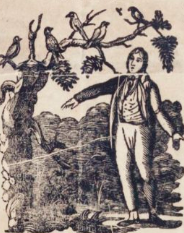Help us get to over 8,755 articles in 2024.
If you know of a magician not listed in MagicPedia, start a New Biography for them. Contact us at magicpediahelp@gmail.com
Magicpedia:Today's featured article: Difference between revisions
No edit summary |
No edit summary |
||
| (200 intermediate revisions by 5 users not shown) | |||
| Line 1: | Line 1: | ||
<noinclude> | <noinclude> | ||
<div style="border: 1px solid; width: 96%; color: black; padding: 1em; float: left; background: #EFEFEF"> | <div style="border: 1px solid; width: 96%; color: black; padding: 1em; float: left; background: #EFEFEF"> | ||
Previous featured articles are located in [[:Category:Featured Article]] | |||
Proposed candidates are listed in [[:Category:Featured Article Candidate]] | |||
</div> | </div> | ||
__NOTOC__ | __NOTOC__ | ||
{{clear}} | |||
</noinclude> | </noinclude> | ||
[[ | [[File: RichardPotter.png|right|thumb|200px|[[ Richard Potter]]]] | ||
'''Richard Potter''' (b.1783-d.1835) is credited as the first successful stage magician born in the United States and as the first black magician. | |||
== Biography == | |||
Reportedly, Potter was the son of an English baronet, Charles Henry Frankland, and an African American woman (some say "slave"). Frankland, however, died years before Potter was born. Church records from Hopkinton, MA, list his father as George Simpson. His mother's name was Dinah, who was a slave on the Frankland estate. Potter went to England around 1798. There is no record of his actual education. He returned to the United States around 1801, probably with [[John Rannie]], a professional magician whom he started out working for as an assistant in 1802. | |||
One of the earliest records of Potter advertising a show was in Boston, November 2nd, 1811 at the Columbian Museum. He advertised his show as, "An Evening's Brush to Sweep Away Care, or a Medley to Please." | |||
[[Richard Potter|Read more about Richard Potter…]] | |||
Latest revision as of 17:27, 1 November 2024
Previous featured articles are located in Category:Featured Article
Proposed candidates are listed in Category:Featured Article Candidate
Richard Potter (b.1783-d.1835) is credited as the first successful stage magician born in the United States and as the first black magician.
Biography
Reportedly, Potter was the son of an English baronet, Charles Henry Frankland, and an African American woman (some say "slave"). Frankland, however, died years before Potter was born. Church records from Hopkinton, MA, list his father as George Simpson. His mother's name was Dinah, who was a slave on the Frankland estate. Potter went to England around 1798. There is no record of his actual education. He returned to the United States around 1801, probably with John Rannie, a professional magician whom he started out working for as an assistant in 1802.
One of the earliest records of Potter advertising a show was in Boston, November 2nd, 1811 at the Columbian Museum. He advertised his show as, "An Evening's Brush to Sweep Away Care, or a Medley to Please."
